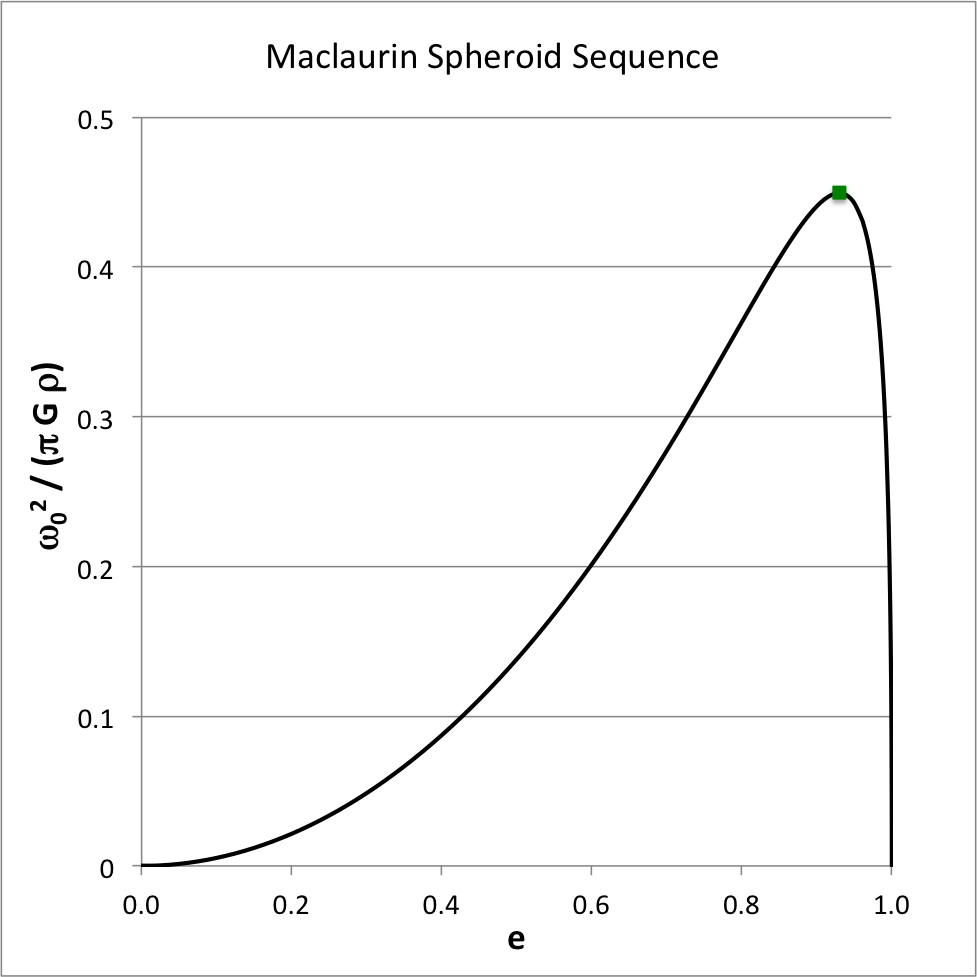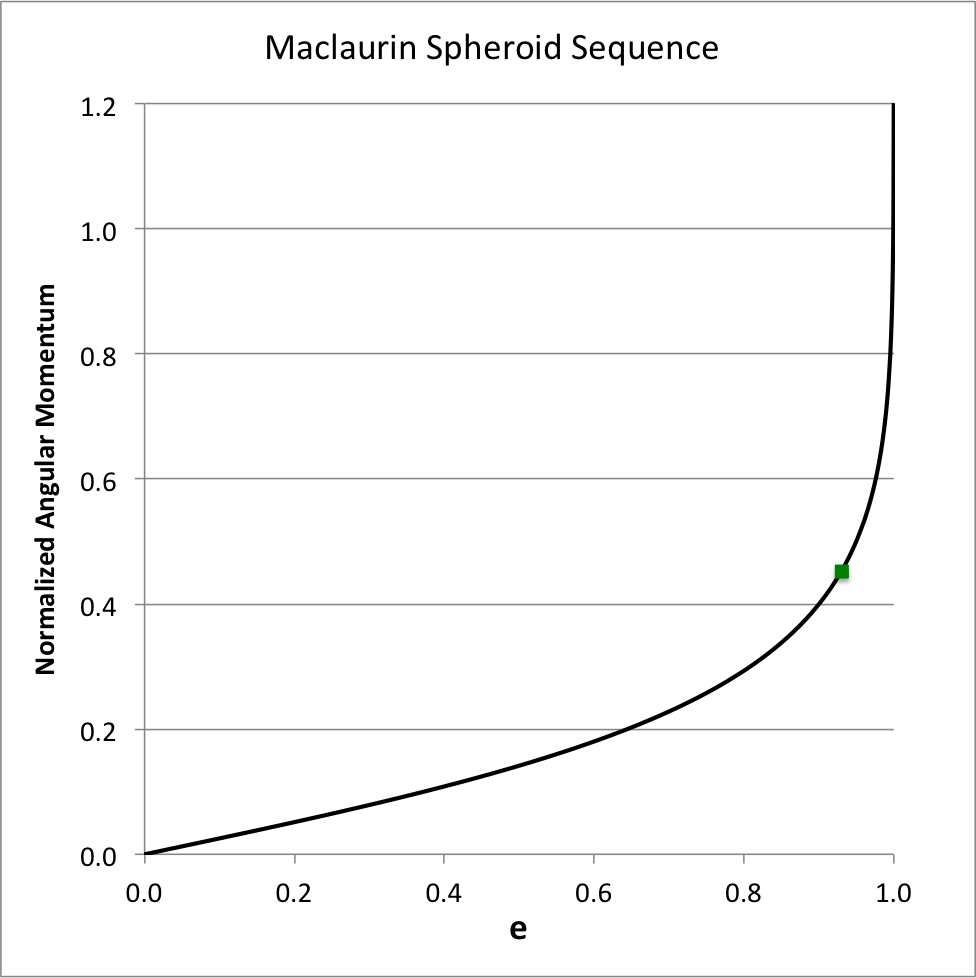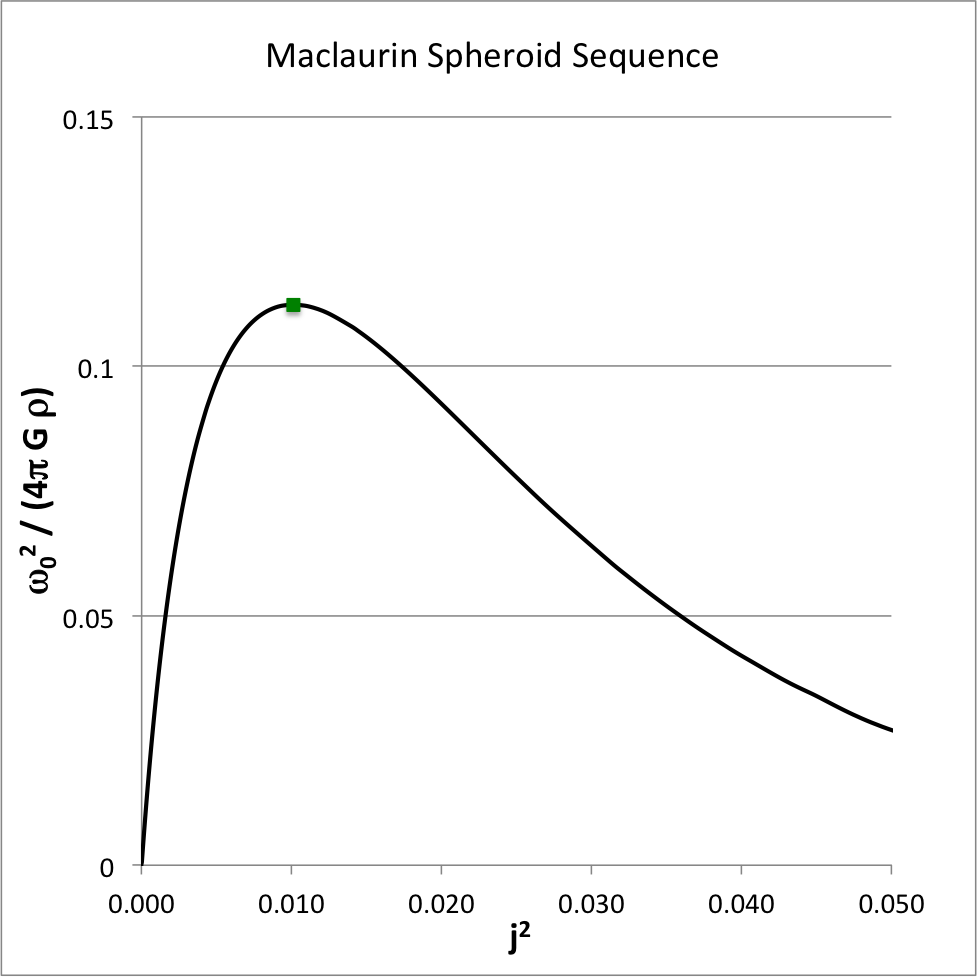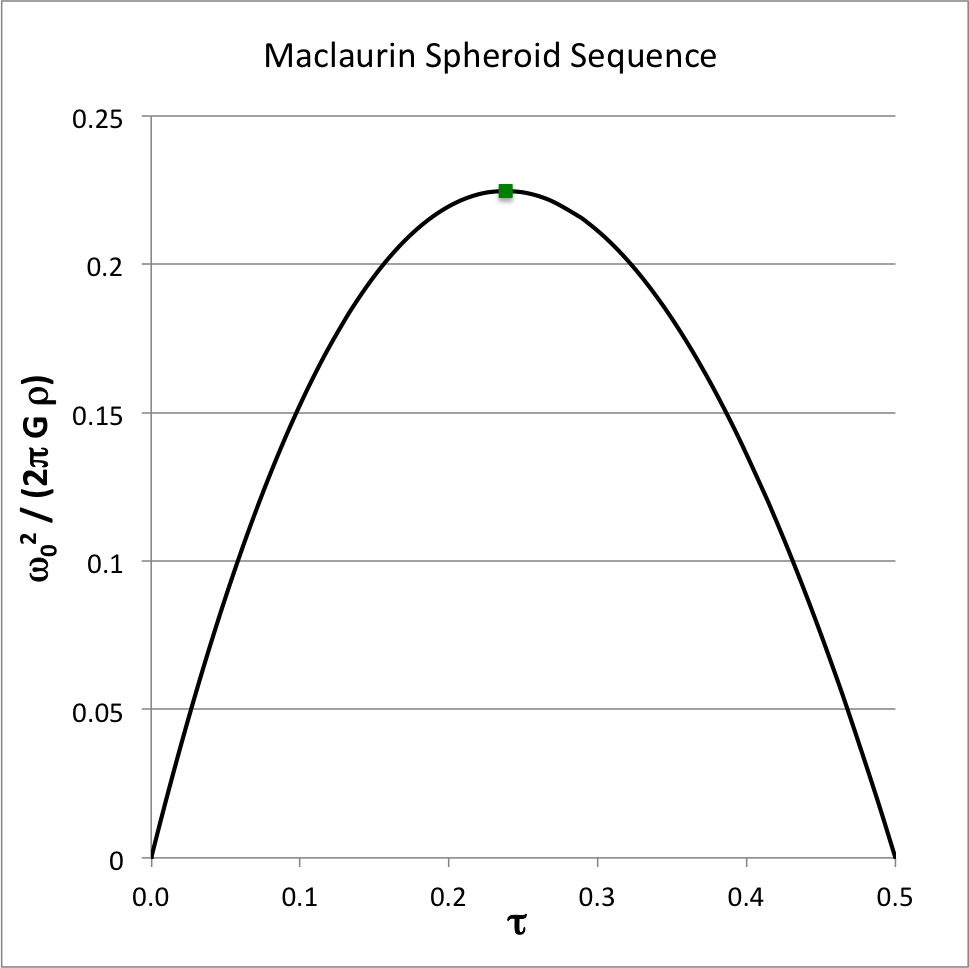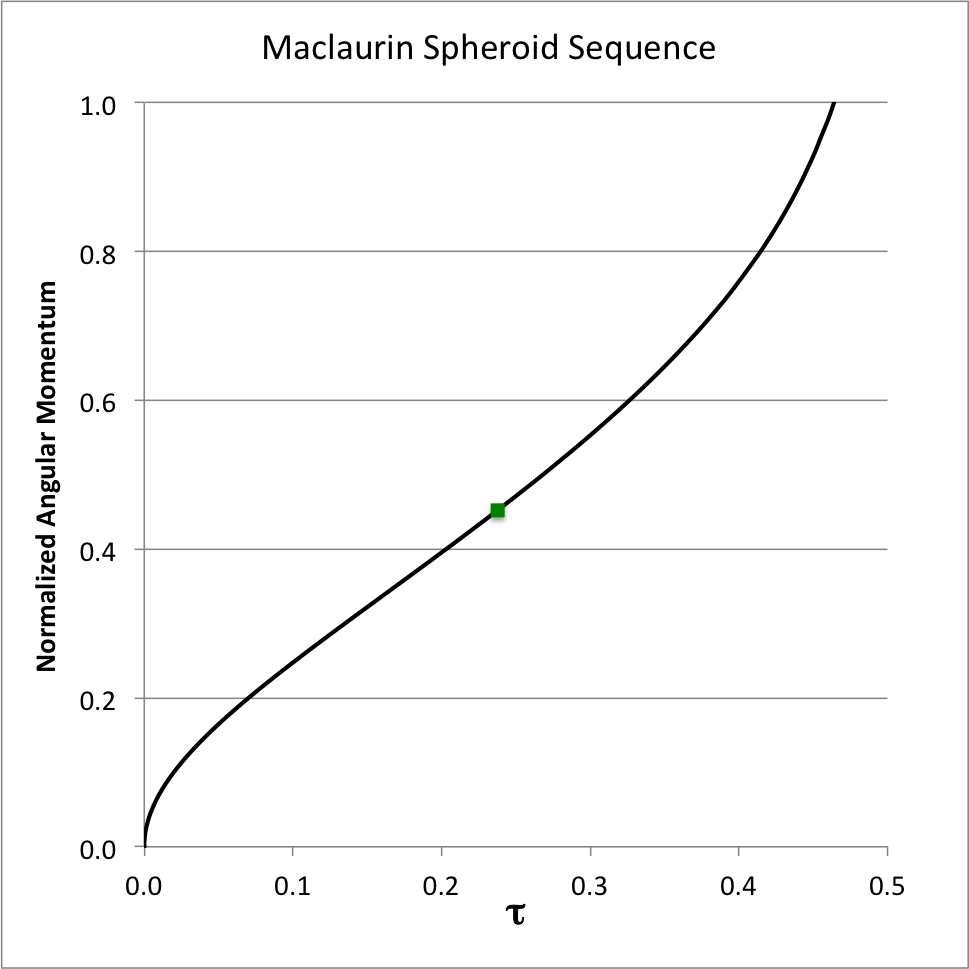Difference between revisions of "User:Tohline/Apps/MaclaurinSpheroidSequence"
| Line 342: | Line 342: | ||
<tr> | <tr> | ||
<td align="center"> | <td align="center"> | ||
<b><math>~\frac{ | <b><math>~\tau \equiv \frac{T_\mathrm{rot}}{|W_\mathrm{grav}|}</math></b> | ||
</td> | </td> | ||
<td align="center"> | <td align="center"> | ||
| Line 357: | Line 357: | ||
<tr> | <tr> | ||
<td align="right"> | <td align="right"> | ||
<math>~ | <math>~T_\mathrm{rot}</math> | ||
</td> | </td> | ||
<td align="center"> | <td align="center"> | ||
| Line 454: | Line 454: | ||
<tr> | <tr> | ||
<td align="right"> | <td align="right"> | ||
<math>~\frac{ | <math>~\tau \equiv \frac{T_\mathrm{rot}}{|W_\mathrm{grav}|}</math> | ||
</td> | </td> | ||
<td align="center"> | <td align="center"> | ||
| Line 504: | Line 504: | ||
</table> | </table> | ||
Building on an [[User:Tohline/Apps/MaclaurinSpheroids#Gravitational_Potential|accompanying discussion of the structure of Maclaurin spheroids]], Table 1 — shown | Building on an [[User:Tohline/Apps/MaclaurinSpheroids#Gravitational_Potential|accompanying discussion of the structure of Maclaurin spheroids]], Table 1 — shown just above, on the right — lists the limiting values of several key functions. Note, in particular, that as the eccentricity varies smoothly from zero (spherical configuration) to unity (infinitesimally thin disk), the energy ratio, <math>~\tau</math>, varies smoothly from zero to one-half. In his examination of the Maclaurin spheroid sequence, [[User:Tohline/Appendix/References#T78|Tassoul (1978)]] chose to use this energy ratio as the ''order parameter'', rather than the eccentricity. Following Tassoul, our Figure 4 shows how the square of the angular velocity varies with <math>~\tau</math>; And again following Tassoul, our Figure 5 shows how the system angular momentum varies with <math>~\tau</math>; here, the angular momentum is normalized to the same quantity used in EFE. | ||
As above, the small solid-green square marker identifies the location along the sequence where the system with the maximum angular velocity resides: | |||
<table border="0" align="center"><tr><td align="center"> | <table border="0" align="center"><tr><td align="center"> | ||
| Line 538: | Line 539: | ||
</td></tr></table> | </td></tr></table> | ||
=See Also= | =See Also= | ||
Revision as of 00:15, 28 July 2020
Maclaurin Spheroid Sequence

|
|---|
| | Tiled Menu | Tables of Content | Banner Video | Tohline Home Page | |
Detailed Force Balance Conditions
| Figure 1 |
|
Solid black curve also may be found as: |
The essential structural elements of each Maclaurin spheroid model are uniquely determined once we specify the system's axis ratio, <math>~c/a</math>, or by the system's meridional-plane eccentricity, <math>~e</math>, where
|
<math>~e</math> |
<math>~\equiv</math> |
<math>~\biggl[1 - \biggl(\frac{c}{a}\biggr)^2\biggr]^{1 / 2} \, ,</math> |
which varies from e = 0 (spherical structure) to e = 1 (infinitesimally thin disk). According to our accompanying derivation, for a given choice of <math>~e</math>, the square of the system's equilibrium angular velocity is,
|
<math> ~ \omega_0^2 </math> |
<math> ~= </math> |
<math> 2\pi G \rho \biggl[ A_1 - A_3 (1-e^2) \biggr] \, , </math> |
where,
|
<math> ~A_1 </math> |
<math> ~= </math> |
<math> \frac{1}{e^2} \biggl[\frac{\sin^{-1}e}{e} - (1-e^2)^{1/2} \biggr](1-e^2)^{1/2} \, , </math> |
|
<math> ~A_3 </math> |
<math> ~= </math> |
<math> \frac{2}{e^2} \biggl[(1-e^2)^{-1/2} -\frac{\sin^{-1}e}{e} \biggr](1-e^2)^{1/2} \, . </math> |
Figure 1 shows how the square of the angular velocity varies with eccentricity along the Maclaurin spheroid sequence; given the chosen normalization unit, <math>~\pi G\rho</math>, it is understood that the density of the configuration is held fixed as the eccentricity is varied. The small solid-green square marker identifies the location along the sequence where the system with the maximum angular velocity resides:
|
<math>~\biggl[ e, \frac{\omega_0^2}{\pi G \rho} \biggr]</math> |
<math>~\equiv</math> |
<math>~\biggl[ 0.92995, 0.449331 \biggr] \, .</math> |
| [EFE], §32, p. 80, Eqs. (9) & (10) | ||
Alternate Sequence Diagrams
Total Angular Momentum
The total angular momentum of each uniformly rotating Maclaurin spheroid is given by the expression,
|
<math>~L</math> |
<math>~=</math> |
<math>~I \omega_0 \, ,</math> |
where, the moment of inertia <math>~(I)</math> and the total mass <math>~(M)</math> of a uniform-density spheroid are, respectively,
|
<math>~I</math> |
<math>~=</math> |
<math>~\biggl(\frac{2}{5}\biggr) M a^2 \, ,</math> |
and, |
<math>~M</math> |
<math>~=</math> |
<math>~\biggl( \frac{4\pi}{3} \biggr) \rho a^2c \, .</math> |
Hence, we have,
|
<math>~L^2</math> |
<math>~=</math> |
<math>~ \frac{2^2 M^2 a^4}{5^2} \biggl[ A_1 - A_3 (1-e^2) \biggr] 2\pi G \biggl[ \frac{3}{2^2\pi} \cdot \frac{M}{a^2c} \biggr]</math> |
|
|
<math>~=</math> |
<math>~ \frac{6GM^3 {\bar{a}}}{5^2} \biggl[ A_1 - A_3 (1-e^2) \biggr]\biggl(\frac{a}{c}\biggr)^{4/3} </math> |
|
<math>~\Rightarrow ~~~ \frac{L}{(GM^3\bar{a})^{1 / 2}}</math> |
<math>~=</math> |
<math>~ \frac{6^{1 / 2}}{5} \biggl[ A_1 - A_3 (1-e^2) \biggr]^{1 / 2}(1 - e^2)^{-1 / 3} \, ,</math> |
|
where, <math>~\bar{a} \equiv (a^2 c)^{1 / 3} \, .</math> |
||
Figure 2 shows how the system's angular momentum varies with eccentricity along the Maclaurin spheroid sequence; given the chosen normalization unit, <math>~(GM^3\bar{a})^{1 / 2}</math>, it is understood that the mass and the volume — hence, also the density — of the configuration are held fixed as the eccentricity is varied. Strictly speaking, along this sequence the angular momentum asymptotically approaches infinity as <math>~e \rightarrow 1</math>; by limiting the ordinate to a maximum value of 1.2, the plot masks this asymptotic behavior. The small solid-green square marker identifies the location along this sequence where the system with the maximum angular velocity resides (see Figure 1); this system is not associated with a turning point along this angular-momentum versus eccentricity sequence.
|
Figure 3 shows how the square of the angular velocity varies with the square of the angular momentum for models along the Maclaurin spheroid sequence. In generating this plot, following the lead of Eriguchi & Hachisu (1983), we have divided the square of the angular velocity by an additional factor of four, and we have adopted a slightly different angular-momentum normalization, namely,
|
<math>~j</math> |
<math>~\equiv</math> |
<math>~ \biggl( \frac{3}{2^8 \pi^4} \biggr)^{1/6} \frac{L}{(GM^3\bar{a})^{1 / 2}} \, .
</math> |
As above, the small solid-green square marker identifies the location along the sequence where the system with the maximum angular velocity resides:
|
<math>~\biggl[ j^2, \frac{\omega_0^2}{4\pi G \rho} \biggr]</math> |
<math>~\equiv</math> |
<math>~\biggl[ 0.010105, 0.112333 \biggr] \, .</math> |
Energy Ratio, T/|W|
|
Table 1: Limiting Values |
||
|
|
<math>~e=0</math> |
<math>~e=1</math> |
|
<math>~A_1</math> |
<math>\frac{2}{3}</math> |
<math>~0</math> |
|
<math>~A_3</math> |
<math>\frac{2}{3}</math> |
<math>~2</math> |
|
<math>~\frac{\sin^{-1}e}{e}</math> |
<math>~1</math> |
<math>~\frac{\pi}{2}</math> |
|
<math>~\tau \equiv \frac{T_\mathrm{rot}}{|W_\mathrm{grav}|}</math> |
<math>~0</math> |
<math>~\frac{1}{2}</math> |
The rotational kinetic energy of each uniformly rotating Maclaurin spheroid is given by the expression,
|
<math>~T_\mathrm{rot}</math> |
<math>~=</math> |
<math>~ \frac{1}{2}I \omega_0^2 =\frac{Ma^2}{5} \cdot 2\pi G\rho \biggl[ A_1 - (1-e^2)A_3\biggr] </math> |
|
|
<math>~=</math> |
<math>~ \frac{2^3 \pi^2}{3\cdot 5} \cdot G\rho^2 a^4 c \biggl[ A_1 - (1-e^2)A_3\biggr] </math> |
|
|
<math>~=</math> |
<math>~ \frac{2^3\pi^2}{3\cdot 5} \cdot G\rho^2 a^5 \biggl[ \frac{(1-e^2)}{e^3} ~(3 - 2e^2)\sin^{-1}e - \frac{3(1-e^2)^{3 / 2}}{e^2} \biggr] \, ; </math> |
and the gravitational potential energy of each configuration is,
|
<math>~W_\mathrm{grav}</math> |
<math>~=</math> |
<math>~ - \frac{3}{5} \cdot \frac{GM^2}{c} \biggl[ A_1 + \frac{1}{2}(1-e^2)A_3 \biggr] = - \frac{3}{2\cdot 5} \cdot \frac{G}{c} \biggl[ \frac{2^2\pi \rho a^2 c}{3} \biggr]^2 \biggl[ 2A_1 + (1-e^2)A_3 \biggr] </math> |
|
|
<math>~=</math> |
<math>~ - \frac{2^3\pi^2}{3\cdot 5}\cdot G\rho^2 a^4 c \biggl[ 2A_1 + (1-e^2)A_3 \biggr] </math> |
|
|
<math>~=</math> |
<math>~ - \frac{2^4 \pi^2}{3\cdot 5} \cdot G\rho^2 a^5 (1-e^2) \cdot \frac{\sin^{-1}e }{e} \, .</math> |
Hence, the energy ratio,
|
<math>~\tau \equiv \frac{T_\mathrm{rot}}{|W_\mathrm{grav}|}</math> |
<math>~=</math> |
<math>~ \frac{ A_1 - (1-e^2)A_3 }{ 2A_1 + (1-e^2)A_3 } </math> |
|
[T78], §4.5, p. 86, Eq. (53) |
||
|
|
<math>~=</math> |
<math>~ \biggl[ \frac{(1-e^2)}{e^3} ~(3 - 2e^2)\sin^{-1}e - \frac{3(1-e^2)^{3 / 2}}{e^2} \biggr] \biggl[ 2(1-e^2) \cdot \frac{\sin^{-1}e }{e} \biggr]^{-1} </math> |
|
|
<math>~=</math> |
<math>~ \frac{3}{2e^2}\biggl[ 1 - \frac{e(1-e^2)^{1 / 2}}{\sin^{-1} e}\biggr] - 1 \, .</math> |
|
[ST83], §7.3, p. 172, Eq. (7.3.24) |
||
Building on an accompanying discussion of the structure of Maclaurin spheroids, Table 1 — shown just above, on the right — lists the limiting values of several key functions. Note, in particular, that as the eccentricity varies smoothly from zero (spherical configuration) to unity (infinitesimally thin disk), the energy ratio, <math>~\tau</math>, varies smoothly from zero to one-half. In his examination of the Maclaurin spheroid sequence, Tassoul (1978) chose to use this energy ratio as the order parameter, rather than the eccentricity. Following Tassoul, our Figure 4 shows how the square of the angular velocity varies with <math>~\tau</math>; And again following Tassoul, our Figure 5 shows how the system angular momentum varies with <math>~\tau</math>; here, the angular momentum is normalized to the same quantity used in EFE. As above, the small solid-green square marker identifies the location along the sequence where the system with the maximum angular velocity resides:
|
See Also
- Properties of Maclaurin Spheroids
- Excerpts from Maclaurin's (1742) A Treatise of Fluxions
- Properties of Homogeneous Ellipsoids

|
|---|
|
© 2014 - 2021 by Joel E. Tohline |
